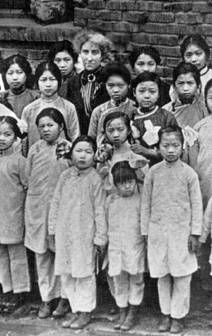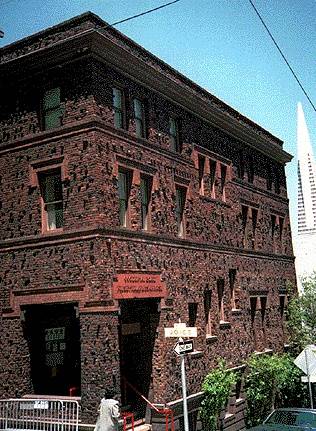Donaldina Cameron House
Historical Essay
by Dr. Weirde
Donaldina Cameron with some of her charges.
Photo: California Society of Pioneers
Cameron House today.
Photo: Chris Carlsson
920 Sacramento Street. From the early 1890's until 1939, 920 Sacramento Street was a rescue mission housing escaped Chinese slave girls. Sexual slavery flourished in Chinatown from the 1870's through the early 20th century. In 1849, Chinese men, like those from other nations, had rushed to the California gold fields. Later, employers such as large railroads, impressed by the hardworking Chinese, imported thousands more. Few women came along. In 1882, Congress passed the first of three Exclusion Acts which for all practical purposes banned further immigration of Orientals. Chinese men could not even send for their wives. As there were roughly 2000 Chinese men for every woman, the inexorable laws of supply and demand led the Chinese tong gangs to smuggle "daughters of joy" from China to San Francisco, where the women were auctioned off. Some were sold as wives or concubines, some as courtesans, and others as common prostitutes. Even very young girls were smuggled and sold; they would serve as domestic slaves until they reached the age of nubility.
The lot of the slave girls was not a happy one. Most wound up as prostitutes, plied their trade for five years or less, and died of venereal diseases before the age of twenty. Over ninety percent were afflicted by one or more STDs, in an age when antibiotics were unknown. Though some of the girls worked in the Parlor Houses, brothels of relative luxury, the majority turned tricks in the Cribs.
In 1873, the same year the first cable car began running, Bay Area church women began campaigning against yellow slavery. Founders of the movement included Mrs. Phoebe Apperson Hearst, grandmother of Patty. By the early 1890's, 920 Sacramento Street was the base of operations for the Christian ladies' war on the sex-slaving Tongs. Women like Margaret Culbertson, and later Donaldina Cameron, not only ran the shelter for escaped sex slaves, but actually led police raids on houses of ill repute and helped carry off "liberated" captives, who were set to work sewing and babysitting their younger housemates. Some girls were legally or illegally re-claimed by their masters, others ran away, some were deported, and a few stayed and ultimately became model citizens. The evangelical Christianity of the mission did not sit well with all of the girls, nor with the entire Chinese community, though relations were generally good. One hostile letter read: "Your religion is vain. It costs too much money. By what authority do you rescue girls? If there is any more of this work there will be a contest and blood may flow. Then we will see who is the strongest. We send you this warning. To all Christian teachers."
The Tongs, of course, despised the Mission; once, in 1895, sticks of dynamite were found on the porch and in the window grating--enough to blow up a city block. But the indefatigable Christian ladies continued their work, rebuilding 920 Sacramento after the 1906 earthquake and continuing their work until 1939, when the decline of yellow slavery made it obsolete.


